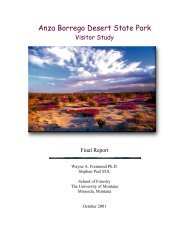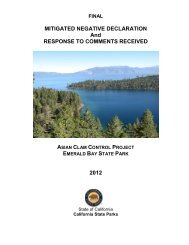Draft EIS/EIR for the San Luis Reservoir SRA Resource ...
Draft EIS/EIR for the San Luis Reservoir SRA Resource ...
Draft EIS/EIR for the San Luis Reservoir SRA Resource ...
You also want an ePaper? Increase the reach of your titles
YUMPU automatically turns print PDFs into web optimized ePapers that Google loves.
5. Environmental Analysis<br />
requires CSP and Reclamation to comply with federal, state, interstate, and local<br />
requirements; administrative authority; and sanctions with respect to <strong>the</strong> control<br />
and abatement of water pollution.<br />
5.4.1.1 Impact Summary<br />
The following mechanisms have <strong>the</strong> potential to affect hydrology, floodplains,<br />
and water quality in <strong>the</strong> Plan Area:<br />
• Facilities maintenance and construction<br />
• Trail and road use, maintenance, and construction<br />
• Motorized vessel emissions<br />
• Human use and waste disposal<br />
• Climate change<br />
Because <strong>the</strong> Plan Area includes few flood-prone areas and development is not<br />
proposed in <strong>the</strong>se areas, none of <strong>the</strong> alternatives would have impacts associated<br />
with flooding and floodplains.<br />
5.4.1.2 Impact Criteria (Hydrology and Floodplain/Water Quality)<br />
• Beneficial Impact (NEPA): Impact that is detectable and positively alters<br />
historical or desired hydrology and floodplain or water quality conditions.<br />
Beneficial impacts would contribute to <strong>the</strong> enhancement of Plan Area<br />
water resources or <strong>the</strong> public’s enjoyment of water resources, or would<br />
advance Plan Area goals <strong>for</strong> water quality. There is no CEQA equivalent<br />
to a NEPA beneficial impact.<br />
• No Impact: Impact that cannot be detected.<br />
• Minor Adverse Impact (NEPA): Impact that is detectable and within or<br />
below regulatory standards or thresholds <strong>for</strong> water quality, and does not<br />
interfere with Plan Area goals. This is equivalent to a CEQA less than<br />
significant impact.<br />
• Major Adverse Impact (NEPA): Impact that is detectable and significantly<br />
and negatively alters historical baseline or desired water quality<br />
conditions. Major adverse impacts would contribute to <strong>the</strong> deterioration of<br />
water quality in <strong>the</strong> Plan Area, diminish <strong>the</strong> public’s enjoyment of Plan<br />
Area resources, or interfere with Plan Area goals <strong>for</strong> water quality. A<br />
major adverse impact is equivalent to a CEQA significant impact, which<br />
would result from one or more of <strong>the</strong> following:<br />
− Violate any water quality standard or waste discharge requirements;<br />
− Substantially deplete groundwater supplies or interfere with<br />
groundwater recharge such that <strong>the</strong>re would be a net deficit in aquifer<br />
volume or a lowering of <strong>the</strong> local groundwater table level;<br />
− Substantially alter <strong>the</strong> existing drainage pattern of <strong>the</strong> site or area,<br />
including through alteration of <strong>the</strong> course of a stream or river, in a<br />
manner that would result in substantial erosion or siltation onsite or<br />
offsite;<br />
5-10 <strong>San</strong> <strong>Luis</strong> <strong>Reservoir</strong> <strong>SRA</strong><br />
<strong>Draft</strong> RMP/GP and <strong>Draft</strong> <strong>EIS</strong>/<strong>EIR</strong>
















